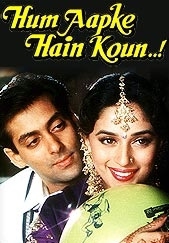So here's some classic films from the popular Indian cinema, starting with one of the most popular films ever produced in Bollywood. Keep in mind that the overall running times for these films will be longer with the advertisements, but I haven't watched them all the way through on You Tube to know how many ads there are typically.
Hum Aapke Hain Koun...! (Sooraj R. Barjatya, India, 1994, 198 minutes)
You Tube: A huge hit when released in India in 1994, director Sooraj Barjatiya's affecting family drama started a notable trend towards more family friendly fare in a time when violence was the predominant attraction of Bollywood films. As Prem's (Salman Khan) brother prepares for his marriage to Nisha's (Madhuri Dixit) sister, the single siblings slowly fall in love with one another. Following the death of Nisha's sister Pooja, Nisha is obligated to marry Prem's brother Rajesh since Rajesh's child is familiar with Nisha. As Nisha and Rajesh prepare for their wedding, Rajesh finds a note that Nisha has written to Prem and insists that she follow her heart and marry her true love. You Tube link.
In addition to being a fun film in itself, Karz is also fun for Bollywood fans because many will recognize it as the source for many visual ideas in the more recent Shah Rukh Khan film, Om Shanti Om.
Karz (Subhash Ghai, India, 1980, 151 minutes)
You Tube: Sir Juda plans to take over the vast estate of Ranimaa, but finds out that the beneficiary is her son, Ravi Verma. He asks Ravi's girlfriend to marry him, and then have him killed accidentally, which she does. This devastates Ranimaa, and leaves the estate open for Sir Juda to take over. Years later, Monty Oberoi, who is a popular singer, surfaces into this story. He has visions of a murder taking place, and is unable to comprehend the meaning of these visions. His travesl take him to Ranimaa's estate, and it is then that he realizes the reason and motive of his birth. You Tube link.
Dil Se (Mani Ratham, India, 1998, 159 minutes)
You Tube: Mani Rathnam, who has proven with films like Bombay (1995) and Iruvar (1998) that it was possible in India to make quality films that could also be box-office hits, chose the 50th anniversary celebrations of Indian Independence as the backdrop for this film about the clash between love and ideology. Amar Kant Varma is the son of a deceased army officer and he lives with his family in Delhi. As a program executive for All India Radio, he travels all over the country to interview common people to mark the anniversary. On one of these trips, he meets a mysterious girl named Meghna at a train station, but loses sight of her before he can get to know her. He sees her again in another town and reminds her of their meeting. Meghna doesn't seem to recognize him. Although she doesn't really want him, he follows her all the way to Ladakh. After two days together, she leaves him to join a group of insurgents on a mission. Amar is heart-broken and marries a girl of his mother's choice. In the meantime, Meghna is chosen to be the main person on a suicide mission targeting the Republic Day Parade. She finds Amar and their destinies entwine. Director Ratnam uses the two characters as symbols for two distinct parts of India at odds with each other -- the big states on the one hand, and the border areas with minority populations on the other. The latter are angry at the central government for having neglected them, which have resulted in a recession. Dil Se, a good example of the energy and imagination of the "Bollywood" movies (referring to Bombay, the "Hollywood of India") from one of the masters of the genre was screened as part of the International Forum of Young Cinema at the 49th International Berlin Film Festival, 1999. You Tube link.




No comments:
Post a Comment